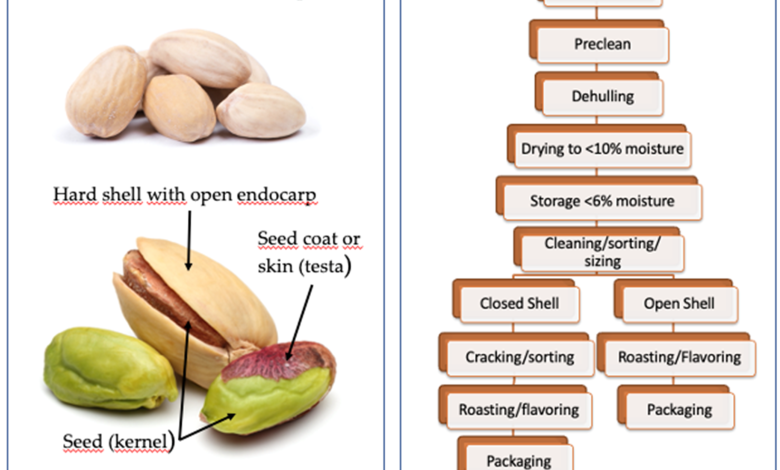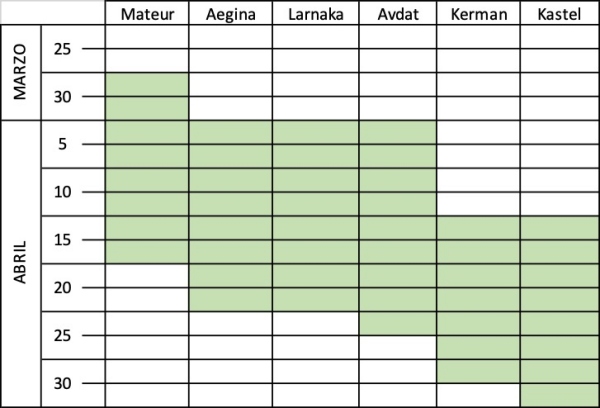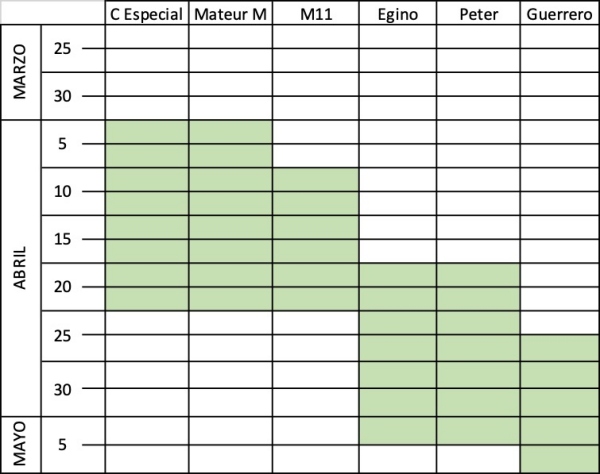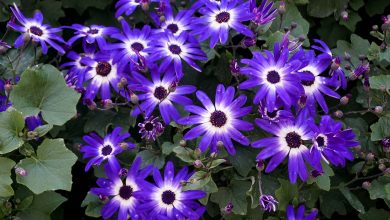Pistachio varieties and rootstocks: How to choose the most suitable

Hello farmers. In today’s article we are going to give you all the keys to decide which variety of pistachio and rootstock to choose. We will see how there are female varieties and male varieties, since it is a dioecious plant.

The variety is the part of the tree that will give us the fruit, while the rootstock is the part that provides the root system, that is, the root, what is below the ground. These two decisions are very important for the establishment of the plantation, since making a mistake in this aspect can cause serious damage in the future.
How to choose the variety of pistachio?
As we already said in the Pistachio cultivation article, the pistachio tree is a dioecious species, with male and female trees. The females are the ones that will bear the fruit, while the males are only in charge of the pollen, that is, they will not produce fruit. In this sense, when we have to decide on a variety based on the fruits, we will only look at the females and later, we will choose the males.
Most relevant pistachio varieties
There are numerous varieties of pistachio grown throughout the world. The main ones are:
female varieties
- Mateur
- Aegina
- larnaka
- Avdat
- Kerman
- Kastel
male varieties
- C Special
- Mateur M
- M11
- aeginus
- Peter
- Warrior
In Spain, the most widespread female variety is Kerman, with the Peter variety as the male. For this reason, the fact of choosing these varieties is already going to be an advantage, since the knowledge about their behavior is much broader compared to what we have about other varieties.
The fundamental factor to select the type of pistachio is going to be the climate, although we will also talk about others such as the size of the fruit, production of empty fruits, yields, etc.
How does the climate influence to choose the variety?
The biggest conditioning factor for choosing the variety is the climate. In this sense, two fundamental criteria must be used: cold hours and late frosts.
What are cold hours?
Cold hours are a very common characteristic among fruit trees. When winter arrives, they go into rest (they fall asleep) until they accumulate all the cold hours necessary to wake up and start flowering. The cold hours are all the hours of the day in which the temperature is less than 7ºC. The number of hours needed to come out of dormancy will depend on the variety, with some needing very few hours (early-flowering varieties) and others needing many (late-flowering varieties).
Varieties with high chilling requirements will be suitable for cold areas, while varieties with lower chilling needs will be chosen for warmer locations.
The importance of late frosts to choose the variety
It is vitally important that there are no late frosts in our area when the pistachio tree begins to flower, as it would cause considerable damage to the trees. In this sense, by choosing a late variety, we will also be reducing the chances of suffering a frost when the pistachio trees are in bloom. Therefore, climatic factors will take precedence over the rest when choosing the variety.
The climate and female varieties
If the plantation is going to be located in a colder area, such as the northern half of the peninsula, we will choose a later variety such as Kerman or Kastel. For areas with milder temperatures, such as southern Spain, we can choose an earlier variety, such as Mateur, since spring frosts are more unlikely.

Climate and male varieties
Once the female variety has been chosen, we have to select the male variety, so we must look at those male varieties whose flowering period overlaps with that of the females, in order to ensure pollination. In fact, if the male comes into bloom a little earlier than the females, it will be even more beneficial.

The vecería in the pistachio
What is the vecería? The vecería is a characteristic of many fruit trees, in which one year they produce a large amount of fruit (ON year), while the following year, said amount is considerably reduced (OFF year). The pistachio tree is a fruit tree that presents an important vecería. Although, this effect can be mitigated with the choice of variety. In this sense, the «best» cultivars would be Larnaka or Avdat and the «worst» would be Kerman, Aegina or Mateur.
Fruit size according to variety
Kerman fruits are larger and more in demand in the market, so their ease and sale price are higher than in other varieties. As negative points, it presents a marked vecería and a higher percentage of empty fruits, compared to other varieties. In terms of fruit size, a good alternative to Kerman would be Kastel, since they will have similar sizes. Although the cultivation of this variety in Spain is not very widespread, its behavior in our region is therefore unknown.

Percentage of empty fruits
The varieties with the lowest production of empty fruits are Larnaka, Avdat or Aegina. As long as we don’t have late frosts, these cultivars can be an interesting option. As has already been said, the first factor to take into account when choosing the variety is frost.
Productivity
This is an important aspect, especially if we are going to produce dry-farmed pistachios. Under drought conditions, the varieties with the highest yields are Mateur, Larnaka and Aegina. For a rainfed production, these varieties would be around 1100 kg/ha, while Kerman would produce about 850kg/ha.
Choice of rootstock. What is the most suitable pattern?
The rootstock, also called rootstock or foot, is the part that will provide the root system of the pistachio tree. We call the root system the set of roots of the tree. The types of rootstock most used in pistachio cultivation are Pistacia terebinthus L. (cornicabra), Pistacia atlantica D. and Pistacia integerrima S., among others. The use of hybrids is increasingly being used, such as UCB1, which would be a cross between P. altantica and P. integerrima, which allows us to combine the advantages of both.
The use of rootstocks is necessary to improve some characteristics of the species from an agronomic point of view, for example, resistance to pests, diseases, weather conditions, soil, etc. Next, we will analyze the pros and cons of each one to help you decide which one to choose for your garden or plantation.
Pistacia terebinthus L. (cornicabra)
This rootstock is indigenous to Spain and the Mediterranean region in general, which is initially an advantage because it means that it is adapted to our conditions.
Advantage
- Good for dry land, with poor and shallow soils.
- Good absorption of copper, zinc and boron.
- High resistance to cold.
- average productions
- Resistant to the presence of limestone in the soil
- Resistance to nematodes and Armillaria and Phytophthora fungi
Disadvantages
- Takes longer to go into production
- Very sensitive to verticillium wilt, a disease caused by the fungus Verticillium, which is very dangerous for the pistachio tree.
Under what conditions would Pistacia terebinthus be recommended?
This rootstock would be among the best options, along with Pistacia atlantica, if our plantation is dry, with poor and shallow soils. It is also the best alternative for clay soils, as it is the one that best tolerates it. Without a doubt, it is the most advantageous option for cold areas such as Castilla y León. It could also be a good option for organic plantations due to its smaller size compared to other rootstocks. Although, as we have already said, we must make sure that our soil does not have Verticillium.
Pistacia atlantica d.
Advantage
- Good rootstock for dry farming and poor soils, although not as good as Pistacia terebinthus
- Average absorption of copper, zinc and boron
- Cold hardy, but less so than Pistacia terebinthus
- The productions are good, similar to Pistacia terebinthus.
- It is also resistant to the presence of limestone
- Greater resistance to Phytophthora than Pistacia terebinthus
Disadvantages
- It also takes time to go into production
- Like Pistacia terebinthus, it is sensitive to Verticillium
- Sensitive to Armillaria (Pistacia terebinthus is resistant)
Under what conditions would Pistacia atlantica be recommended?
As we have already said, Pistacia atlantica is a good option for dry or poor soils. Although, it will prefer sandy or loamy soils, unlike Pistacia terebinthus, which supports clay content. If our plot is in Castilla y León, it would not be the best option due to the cold; it is more suitable for the southern half of the peninsula. As with Pistacia terebinthus, we must ensure that Verticillium is not present.
Pistacia integerrima S.
The main advantage of this rootstock is that it is the only one resistant to Verticillium, in addition to entering production before the rest of the rootstocks. However, the rest of the characteristics make it unsuitable for most areas of Spain: lower production than the previous patterns, less adaptation to poor soils, not recommended in dry conditions, very sensitive to cold, less capacity to absorb nutrients, etc..
So where would it be suitable for? Warm areas, with winters that are not too cold, or late frosts, and soils with serious Verticillium problems.
UCB1 pattern
This pattern results from the hybridization between Pistacia atlantica and Pistacia integerrima, thus achieving the advantages that most interest us from both. On the one hand, thanks to Pistacia atlantica, we are going to obtain an acceptable resistance to cold and, on the other hand, Pistacia integerrima is going to provide us with resistance to Verticillium.
However, its adaptation to poor or rainfed soils is not as good as that of Pistacia terebinthus. In contrast, we can say that its production is slightly higher under irrigation than Pistacia atlantica and Pistacia terebinthus. It has lower efficiencies in the absorption of nutrients, so the expenses in fertilization will increase. In addition, its greater growth will also cause pruning expenses to increase.
Under what conditions would UCB1 be recommended?
Mainly for cold areas that in turn have Verticillium problems.
References
- Couceiro, JF, Guerrero, J., Gijón, MC, Moriana, A., Pérez, D., & Rodríguez, M. (2017).The cultivation of the pistachio (2nd ed.). Mundi-Press. Link on Amazon: https://amzn.to/3bbEq7f
- Guerrero, J., Moriana, A., López, JF, Mendiola, MA, & Gijón, MC (2005). The pistachio tree: choice of variety and rootstock in Castilla La Mancha.Professional Fruit Growing, 150, 14–18.

![Photo of Guano: [Fertilizer, Benefits, Nutrients and How to Prepare it]](https://www.complete-gardening.com/wp-content/uploads/2021/06/guano_1592041110-390x220.jpg)
![Photo of Madagascar Jasmine: [Growing, Care, Pests and Diseases]](https://www.complete-gardening.com/wp-content/uploads/2022/08/madagascar-jasmine-growing-care-pests-and-diseases-390x220.jpg)
![Photo of Complete Guide on How to Grow Vanilla: [Steps + Images]](https://www.complete-gardening.com/wp-content/uploads/2022/08/complete-guide-on-how-to-grow-vanilla-steps-images-390x220.jpg)
